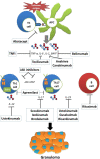Emerging Molecular Targets for the Treatment of Refractory Sarcoidosis
- PMID: 33330556
- PMCID: PMC7732552
- DOI: 10.3389/fmed.2020.594133
Emerging Molecular Targets for the Treatment of Refractory Sarcoidosis
Abstract
Sarcoidosis is a multisystem granulomatous disease of unknown origin that has variable clinical course and can affect nearly any organ. It has a chronic course in about 25% of patients. Corticosteroids (CS) are the cornerstone of therapy but their long-term use is associated with cumulative toxicity. Commonly used CS-sparing agents include methotrexate, cyclophosphamide, azathioprine, and mycophenolate mofetil. Twenty to forty percentage of sarcoidosis patients are refractory to these therapies or develop severe adverse events. Therefore, additional and targeted CS-sparing agents are needed for chronic sarcoidosis. Macrophage activation, interferon response, and formation of the granuloma are mainly mediated by T helper-1 responses. Different pro-inflammatory cytokines such as interleukin (IL)-8, IL-12, IL-6, and tumor necrosis factor-alpha (TNF-α) have been shown to be highly expressed in sarcoidosis-affected tissues. As a result of increased production of these cytokines, Janus kinase-signal transducer and activator of transcription (JAK-STAT) signaling is constitutively active in sarcoidosis. Several studies of biological agents that target TNF-α have reported their efficacy and appear today as a second line option in refractory sarcoidosis. Some case series report a positive effect of tocilizumab an anti-IL-6 monoclonal antibody in this setting. More recently, JAK inhibition appears as a new promising strategy. This review highlights key advances on the management of chronic refractory sarcoidosis. Novel therapeutic strategies and treatment agents to manage the disease are described.
Keywords: JAK inhibitors; granuloma; interleukin-1; interleukin-6; sarcoidosis; therapy.
Copyright © 2020 Boleto, Vieira, Desbois, Saadoun and Cacoub.
Figures

References
Publication types
LinkOut - more resources
Full Text Sources
Research Materials

